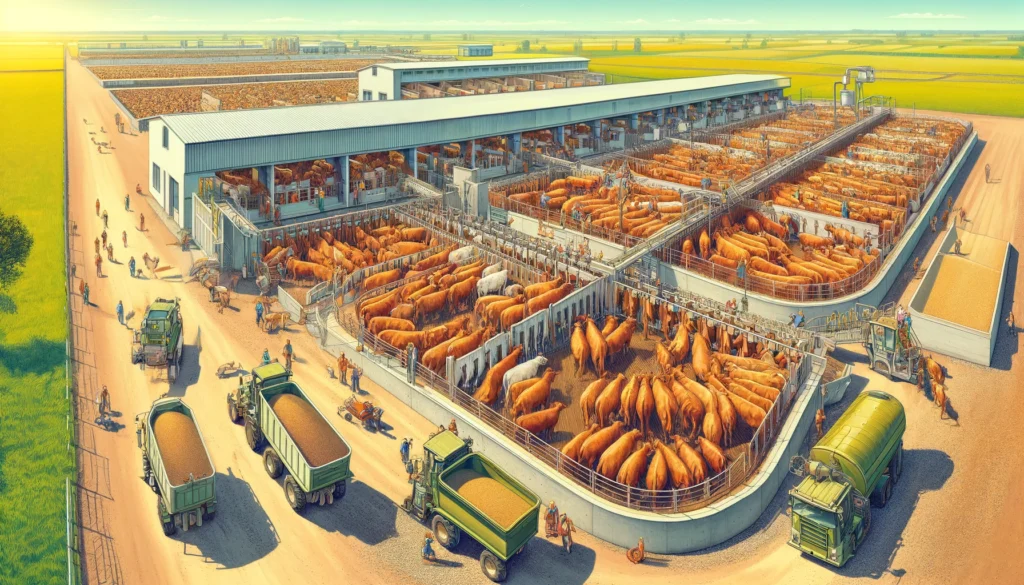
Feedlot Management Definition A vivid and detailed wide aspect illustration of feedlot management in an agricultural setting. The scene depicts a large feedlot with numerous cattle.webp.webp
Definition:
Feedlot management encompasses the strategic planning, operations, and daily practices involved in efficiently and responsibly raising livestock in confined feeding facilities known as feedlots. Feedlots, also referred to as concentrated animal feeding operations (CAFOs), provide a controlled environment for feeding, housing, and managing animals destined for meat production, such as cattle, sheep, and swine.
Key Components of Feedlot Management:
- Facility Design and Layout: Feedlot design considerations include layout, pen configuration, drainage systems, feeding infrastructure, and environmental controls. Well-designed facilities optimize space utilization, promote animal comfort and welfare, and facilitate efficient feeding, handling, and waste management practices.
- Nutrition and Feeding Programs: Developing and implementing appropriate nutrition and feeding programs is essential to meet the dietary requirements of livestock, support growth and performance objectives, and optimize feed efficiency. Feedlot diets typically consist of high-energy feed ingredients, such as grains and by-products, supplemented with protein, minerals, and vitamins.
- Health and Veterinary Care: Maintaining animal health and welfare is a priority in feedlot management. This involves disease prevention strategies, vaccination programs, parasite control measures, and regular health monitoring by qualified veterinarians. Prompt diagnosis and treatment of illnesses, along with biosecurity protocols, help minimize disease risks and maintain herd health.
- Environmental Management: Effective environmental management practices are necessary to minimize the environmental impact of feedlot operations, including nutrient runoff, air emissions, and waste disposal. Strategies such as nutrient management planning, runoff control measures, and waste recycling or treatment systems help mitigate environmental risks and ensure regulatory compliance.
- Animal Handling and Welfare: Proper animal handling techniques and facilities are essential to minimize stress, injury, and behavioral issues in feedlot animals. Training employees in low-stress handling methods, providing suitable handling facilities, and implementing animal welfare standards promote humane treatment and improve productivity and meat quality.
Regulatory Compliance:
Feedlot operations are subject to regulatory oversight and compliance requirements aimed at safeguarding animal health, environmental quality, and public health and safety. Regulations may vary by region and jurisdiction but commonly address aspects such as waste management, water quality, air emissions, animal welfare, and food safety.
Fall off the barn roof and busted your keister? Life on the farm or ranch can be tough on the bum. Need a break? Laugh it off at FarmerCowboy.com, the #1 farm humor site. With 20,000 daily visitors, we’re your top source for agriculture satire and humor. Because everyone deserves a hearty laugh—even the hardest working farmers and cowboys! Join us and turn those long days into fun tales at FarmerCowboy.com.
Best Practices in Feedlot Management:
- Record Keeping and Documentation: Maintaining detailed records of feedlot operations, including animal health records, feed formulations, medication usage, and environmental monitoring data, supports informed decision-making, regulatory compliance, and performance evaluation.
- Quality Assurance and Food Safety: Implementing quality assurance programs and food safety protocols ensures the production of safe, wholesome meat products for consumers. Adhering to good manufacturing practices, sanitation standards, and traceability systems throughout the production chain enhances consumer confidence and market competitiveness.
- Continuous Improvement: Embracing a culture of continuous improvement fosters innovation, efficiency, and sustainability in feedlot management. Regular evaluation of production practices, performance metrics, and feedback from stakeholders allows for identification of opportunities for optimization and adaptation to changing market conditions and industry trends.
Conclusion:
Feedlot management plays a pivotal role in modern livestock production systems by providing a controlled environment for efficiently raising animals for meat production. By integrating sound management practices, technological innovations, and regulatory compliance measures, feedlot operators can optimize animal health and welfare, environmental stewardship, and production efficiency while meeting the demands of consumers and markets for safe, sustainable, and high-quality meat products.
Originally posted 2015-10-19 22:18:25.
Originally posted 2024-07-06 14:00:52.
Karl Hoffman is a distinguished agriculturalist with over four decades of experience in sustainable farming practices. He holds a Ph.D. in Agronomy from Cornell University and has made significant contributions as a professor at Iowa State University. Hoffman’s groundbreaking research on integrated pest management and soil health has revolutionized modern agriculture. As a respected farm journalist, his column “Field Notes with Karl Hoffman” and his blog “The Modern Farmer” provide insightful, practical advice to a global audience. Hoffman’s work with the USDA and the United Nations FAO has enhanced food security worldwide. His awards include the USDA’s Distinguished Service Award and the World Food Prize, reflecting his profound impact on agriculture and sustainability.







If you want to hear real country music, head over to Farm.FM, where songwriting is as genuine as the farmers who live it.